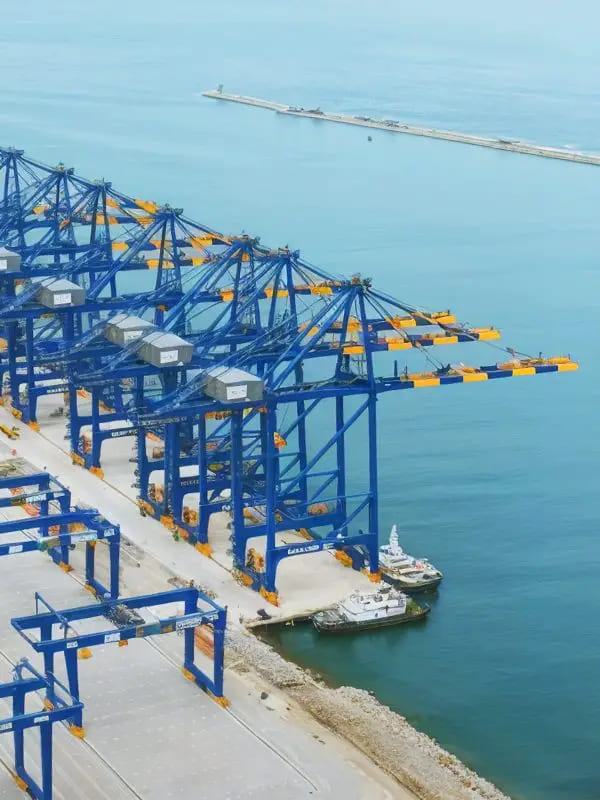
The Vizhinjam International Deepwater Multipurpose Seaport, located in Kerala, stands as a monumental achievement in India's maritime infrastructure.
Inaugurated on May 2, 2025, by Prime Minister Shri Narendra Modi, this ₹8,800 crore project underscores India's commitment to enhancing its port capabilities and fostering economic growth through strategic maritime initiatives.
Why Vizhinjam?
It was chosen for the development of this multi-purpose port because of its strategic location near international shipping routes, which significantly reduces transit times for vessels, making it a pivotal point for maritime trade. As one of India's few natural deep-water ports, this port can efficiently accommodate large cargo and container ships, thus making it an ideal choice for this development.
Features of Vizhinjam Seaport
Strategically located near one of the world's busiest sea trade routes.
Benefits of Vizhinjam Seaport
The development of this port is expected to significantly reduce India's reliance on foreign ports for trans-shipment, which previously accounted for 75% of such operations, thereby retaining revenue within the countryand creating new economic opportunities for Kerala and its people.
Important Initiatives by the Government to promote India's Ports, Shipping, and Waterways Sector
Government of India's initiatives like the Sagarmala Project and PM Gati Shakti, aimed at enhancing port infrastructure and improving inter-connectivity of waterways, railways, highways, and airways. Over the past decade, investments under Public-Private Partnershipshave upgraded Indian ports to global standards, reducing ship turn-around time by 30% and doubling the capacity of ports. These efforts have positioned India among the top three countries globally in terms of seafarer numbersand among the top 20 in global shipbuilding. For further strengthening India's maritime sector, the government is working towards the establishment of a shipbuilding and repair cluster in Kochi, which will create numerous employment opportunities. Additionally, initiatives like the Maritime Amrit Kaal Vision and the India-Middle East-Europe Economic Corridor, which was discussed during the G-20 Summit, underscore Kerala's critical role in global trade networks.
One Nation One Port
The ‘One Nation One Port Process (ONOP)’ initiativefocuses on mapping and standardizing port processesand documentation. This involves conducting a comprehensive review of the existing procedures and documents exchanged within the port value chain across all major ports which cover various cargo types, including containers, dry bulk, and liquid bulk, as well as different movement categories such as export-import, trans-shipment, and coastal operations. The implementation of the ONOP initiative is anticipated to significantly reduce paperwork by approximately 25% for both container operations and bulk cargo, leading to a reduction in logistics costs.
Master Plan to Develop Mega Ports
Six port clusters, out of which four port clusters, namely, Cochin – Vizhinjam Port cluster, Galathea South BayPort, Chennai – Kamarajar – Cuddalore Port cluster, Paradip and other Non-Major Ports cluster with capacity of more than 300 Million Tonnes Per Annum (MTPA)and two port clusters, namely, Deendayal and Tuna Tekra Port cluster, Jawaharlal Nehru – Vadhavan Portcluster with capacity of more than 500 MTPA are being developed as Mega Ports by the year 2047. These activities are included in the Maritime Amrit Kaal Vision, 2047. The works for infrastructure enhancement and capacity augmentation in the Major Ports are already under progress through Public Private Partnership (PPP) mode and also through internal resources.
Conclusion
The inauguration of the Vizhinjam International Deepwater Multipurpose Seaport marks a transformative moment in India's maritime journey, reinforcing the nation's commitment to becoming a global trade and logistics hub.
With its strategic location, state-of-the-art infrastructure, and alignment with key government initiatives like Sagarmala, PM Gati Shakti, and the Maritime Amrit Kaal Vision 2047, Vizhinjam is poised to significantly boost India's economic growth, regional connectivity, and global shipping competitiveness.
As India steers into a future shaped by integrated transport corridors like the India-Middle East-Europe Economic Corridor, the Vizhinjam Seaport stands as a beacon of progress, sustainability, and strategic foresight in the country’s maritime renaissance.